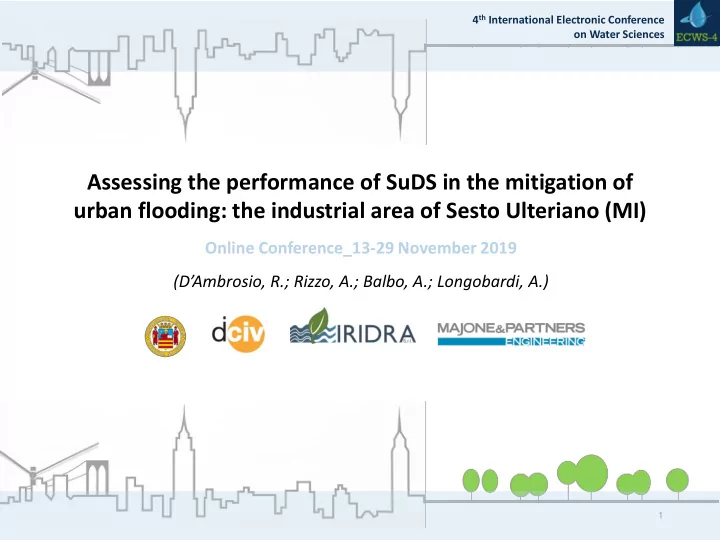

4 th International Electronic Conference on Water Sciences Assessing the performance of SuDS in the mitigation of urban flooding: the industrial area of Sesto Ulteriano (MI) Online Conference_13-29 November 2019 ( D’Ambrosio , R.; Rizzo, A.; Balbo, A.; Longobardi, A.) 1
INTRODUCTION Frequent urban flooding phenomena and heat islands, effects of a substantial increase in the impervious surface of the large urban agglomerations, have forced administrations to face problems linked to the inability of traditional urban drainage systems to manage stormwater in an efficient and sustainable way. Fundamental in this context are sustainable drainage technologies (for example the Sustainable Drainage Systems, SuDS) which, by simulating the drainage patterns of natural elements, bring urban systems back to a configuration that is more similar to that prior to intensive construction. 2
MATERIALS AND METHODS This study, therefore, starting from a project proposal by Studio Majone Engineers Associate, IRIDRA, Studio Gioia Gibelli, Studio Idrogeotecnico and funded by PoliS- Lombardia, aims to evaluate the benefits deriving from the widespread application of sustainable drainage infrastructures in the industrial area of Sesto Ulteriano (MI), a basin of about 330 ha. First steps: • Analysis of the urbanized area, subdivided into 5 different macro-basins, and definition of reference models on the basis of which articulate diffused drainage interventions (models: industrial areas, roads, green areas, residential areas). • Design and location of SuDS for each of the components highlighted in each study model (buildings, squares, sidewalks, parking lots, uncultivated areas, etc.). 3
MATERIALS AND METHODS Next steps: • Implementation in SWMM5 of the different types of SuDS that fell in each sub-basin of the SU drainage network (1148 knots, 1141 pipelines, 36 km network). • From the comparison between the distribution on the territory of the sub-basins of the drainage network (.inp) and the spatial distribution of the different types of sustainable technologies (.qgz), identification of the areas of each SuDS to be attributed to each sub-basin. • Experimentation of a semi-automatic procedure for the calculation and attribution of parameters and areas destined for sustainable infrastructures to each sub-basin of the sewerage. • Simulations for verifying the behaviour of the drainage network in the traditional context and in that with SuDS. 4
RESULTS The simulation outputs carried out with synthetic rain inputs (T = 5, 10 years) made it possible to identify for the two different scenarios the Q max outgoing from each OUTFALLS which, compared with the maximum allowed for compliance with the invariance principle (40l / s per ha of impervious surface), allowed to calculate the overflow from each outfall. 5
RESULTS Graphs show a visible reduction in the overflow volume (which can also be translated into a substantial reduction in the volumes to be foreseen in the design of first storage tanks) after SuDS application and a greater effectiveness of these systems in the case of shorter return times. 20% reduction for T = 5, 7% reduction for T = 10. It is also possible that the reduction percentage can also vary in function of the position of the outfalls (industrial zone A, C, E, greater possibility of transformation). A B C D E A B C D E Overflow before and after implementation of SuDS 6
References 1. Galea, S.; Ettman, C. K.; Vlahov, D., Urban Health ; Oxford University Press: Oxford, United Kingdom, 2019. 2. Tutino, J.; Melosi, W., New World Cities: Challenges of Urbanization and Globalization in the Americas ; The University of North Carolina Press: Chapel Hill, Carolina del Nord, Stati Uniti, 2019. 3. Masi, F.; Rizzo, A.; Bresciani, R., Sustainable Rainwater Management in the City: Opportunities and Solutions for the Anthropic Environmental Impacts Reduction and Urban Resilience Increase. In Smart Metropolia ; Obszar Metropolitalny Gdansk-Gdynia-Sopot ul. Dlugi Targ 39/40, 80-830 Gdansk, 2018, 109-119. 4. D’Ambrosio , R.; Sassone, P.; Longobardi, A., Sustainable strategies for flood risk management in urban areas. Enhancing city resilience with SuDS, UPLanD-Journal of Urban Planning, Landscape & Environmental Design (under review). 5. Ballards, B. W.; Wilson, S.; Udale-Clarke, H.; Illman, S.; Scott, T.; Ashley, R.; Kellagher, R., The SuDS Manual ; CIRIA, London, United Kingdom, 2015. 7
Recommend
More recommend